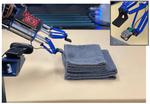Other

“Researchers in Carnegie Mellon University’s Robotics Institute (RI) have designed a system that makes an off-the-shelf quadruped robot nimble enough to walk a narrow balance beam — a feat that is likely the first of its kind. “This experiment was …

“Carnegie Mellon University engineers have developed a soft material with metal-like conductivity and self-healing properties that is the first to maintain enough electrical adhesion to support digital electronics and motors. This advance, published in Nature Electronics, marks a breakthrough in …

“Sheng Shen’s novel 3D graphene-nanowire “sandwich” can enable a wide variety of electronic systems to operate at a lower temperature with higher performance. As devices get smaller and more powerful, the risk of them overheating and burning out increases …

“Researchers from Pittsburgh and Hong Kong print intricate, 2D and 3D patterns Carnegie Mellon University’s Yongxin (Leon) Zhao and the Chinese University of Hong Kong’s Shih-Chi Chen have a big idea for manufacturing nanodevices. Zhao’s Biophotonics Lab …

“This little robot can go almost anywhere. Researchers at Carnegie Mellon University’s School of Computer Science and the University of California, Berkeley, have designed a robotic system that enables a low-cost and relatively small legged robot to climb and …

“New research from Carnegie Mellon University’s Robotics Institute (RI) can help robots feel layers of cloth rather than relying on computer vision tools to only see it. The work could allow robots to assist people with household tasks like …

“Novel Method Developed by CMU Researchers Allows Robots To Learn in the Wild. The robot watched as Shikhar Bahl opened the refrigerator door. It recorded his movements, the swing of the door, the location of the fridge and more, analyzing …

“The much-anticipated launch of the James Webb Space Telescope will usher in a new era of research on our universe. Among the many researchers planning to take advantage of the data from the Hubble Space Telescope’s successor is Carnegie …

“New method saves time, money in developing new drugs An algorithm designed by researchers from Carnegie Mellon University’s Computational Biology Department and St. Petersburg State University in Russia could help scientists identify unknown molecules. The algorithm, called MolDiscovery, uses …

“An international team of collaborators has made the first direct observation of the anionic redox reaction in a lithium-rich battery material. The research opens up pathways for improving existing battery cathodes—and designing new ones. Batteries have come a long …

